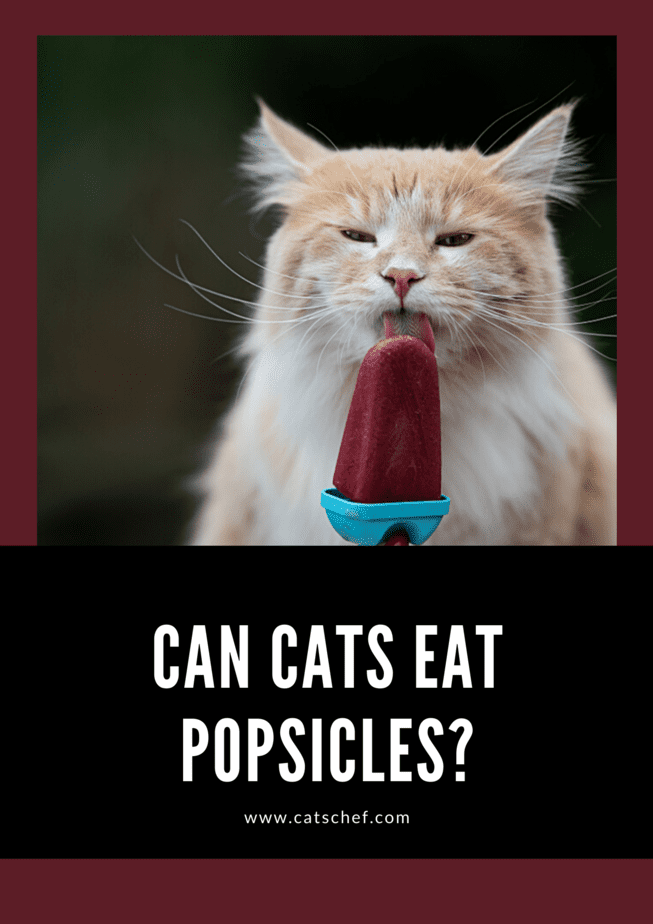Frozen liquid snacks on a stick – there are few things more refreshing than ice-cold popsicles on a summer’s day! You might have wondered if cats can eat popsicles while seeing her panting in the hot sun.
Ice pops are a great way to entertain kids and yourself. They help us cool down in the sweltering heat. But what about cats, how can they cool down?
What are popsicles and can cats safely eat them?
Popsicles are flavored liquids that are quiescently frozen, meaning they become firm ice bricks after having rested in a frozen state. Popsicles are widespread and a great choice of treats when it’s hot outside.
Popsicle is actually a brand of ice pop made by Good Humor-Breyers that consists of flavored, colored ice on a stick. 90% of an ice pop is made up of water, while sugar, corn syrup, gum, and stabilizers are among the other ingredients.
Looking at the main ingredient, you might think this is amazing because water can’t hurt your feline. And that’s true due to water being an essential part of all life forms.
Yet, other ingredients like sugar ruin the healthiest drink. Let’s dig into the ingredients that determine whether or not cats can eat popsicles.
1. Sugar

Sugar is a simple carb and therefore, not beneficial to cats. Felines don’t require carbohydrates as a part of their diet. A certain amount of carbs won’t hurt them, but it won’t do them any good either.
This being said, sugar isn’t something cats find joy in. It may sometimes appear as if your furball is having the time of her life licking popsicles, but it’s not the case. She’s probably more intrigued by the small amount of fat that’s contained in popsicles, rather than the sweet sugary flavor.
If you’re still convinced she’s intrigued by the sugar, remember she doesn’t have the required taste buds to perceive sweetness. This has to do with cats being carnivores.
To survive in the wild, your feline’s ancestors went through a series of mutations. This allowed cats to develop receptors and senses needed for their survival and they survived off of meat. The taste buds that detected carbs, such as sugar, were eliminated.
So, cats are not fond of sugar but don’t hate it either. It’s just that they are incapable of tasting it. So don’t think your cat is crazy about sugar if she has a few licks of your ice pop.
A bit of sugar won’t be momentarily harmful to your kitten. It depends on how a feline’s individual body reacts. She may feel a bit nauseous and have to deal with diarrhea.
But the consequences of sugar intake are worse in the long term. If sugar is consumed for a certain period, there could be some aftereffects. This could include your cat becoming obese, which leads to health issues, such as weakness of joints.
Other, more severe problems could come in terms of teeth problems, such as cavities. Tooth decay can leave your cat without her most valuable weapon.
If this isn’t enough to keep your feline from eating sugar, remember that cats can develop diabetes just like humans. So when it comes to sugar, throw away that popsicle you’ve been saving for your cat. It very well may save her.

2. Artificial sweeteners
As if sugar isn’t enough, artificial sweeteners are often added to the process of making popsicles. These sweeteners are often used in sugar-free items, even popsicles. The goal is to reduce the amount of sugar and by doing that, to maintain low-calorie levels.
Common artificial sweeteners used in popsicles are aspartame, sucralose, and acesulfame potassium. While these sweeteners aren’t poisonous to your cat, it doesn’t mean they won’t harm her in the long run.
Long-term exposure to these sweeteners can result in kidney problems, poor eyesight, headaches, and many more ailments.
However, some serious dangers are lurking behind these artificial elements. The name that should be widely known in the cat world – xylitol. Even the smallest amount, like a piece of gum, can be fatal to your cat.
Xylitol is an artificial sweetener that’s common in baked goods and candy. You can never be sure whether the amount of xylitol in sweets is safe for your feline. Artificial sweeteners are one of the reasons cats can, yet really shouldn’t eat popsicles.
3. Milk
This dairy product is an eternal misconception in the feline world. While some cats can safely digest milk, the majority will find difficulty in doing so. You can probably guess the reason behind this one.
It’s sugar, again. But not the human condiment of these modern days. It’s a sugar that’s found in cow’s milk more than others – lactose. The problem is cats can’t digest it because they lack the enzymes needed for digestion.
The term lactose intolerance is used for describing the condition where your cat can’t break down lactose from milk. This sounds familiar, right? Either way, your cat should avoid sugar, whether it be a table condiment or found in milk.
Can cats eat ice cream? Is it dangerous?
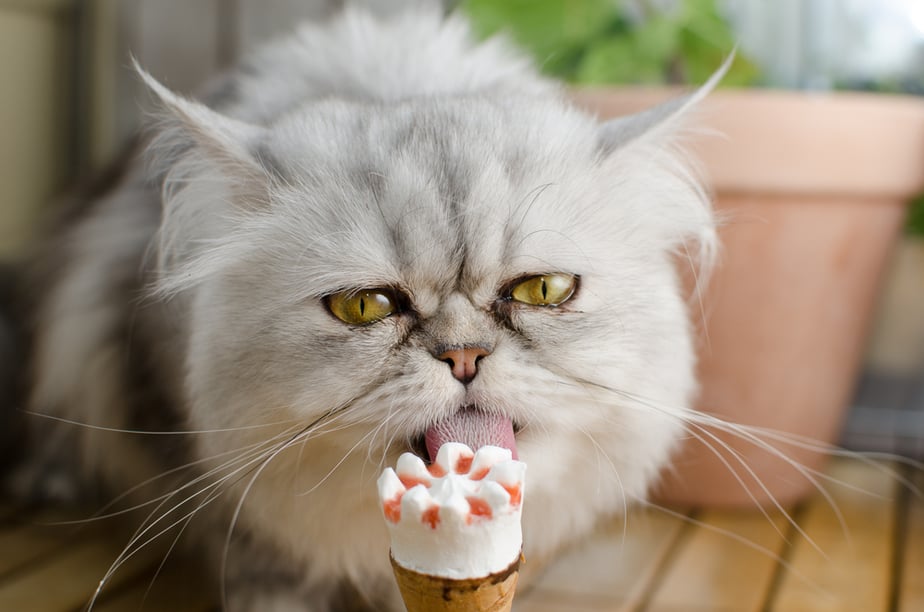
While the majority of popsicles’ content is water, here is a different case. The main ingredient of ice cream is milk. In other words, if you had to choose, popsicles might be a better choice for your feline than ice cream.
Ice cream isn’t necessarily dangerous for your fluff. However, it can cause her stomach distress, often leading to diarrhea. A few licks of ice cream can be tolerated, but make sure this happens only on rare occasions.
The reason your cat enjoys ice cream isn’t because of the flavor or color. It’s because of the fat content. Milk fat is usually added in larger quantities because it results in richer ice cream.
Next to sugar, other sweeteners such as glucose syrups, are often mixed to help emphasize the flavor. They are not safe for humans or cats. These liquid sweeteners are full of sugar and calories which are not beneficial to a feline’s health.
What also appears in ice cream’s list of ingredients are stabilizers. These modifying agents, such as gelatin, often attract your feline companion. She is attracted to gelatin because it’s derived from animals.
Gelatin is safe for cats and often mixed with wet cat food. It’s a great source of animal protein that felines need, but its content in ice cream will be of no use. Next to other non-beneficial ingredients, gelatin loses its nutritional purpose.
A whole range of flavors is available for every taste and preference. Chocolate, vanilla, and fruits are among the well-known flavors of ice cream.
The dangers of chocolate ice cream
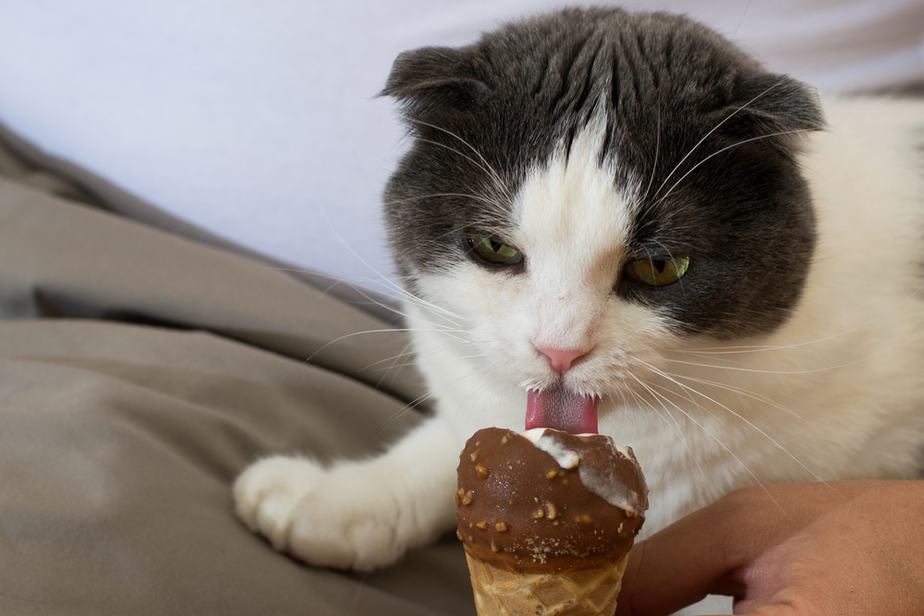
With the already existing health risks of eating regular ice cream, the risks quadruple if it’s chocolate-flavored. In short, your feline should stay far away from chocolate ice cream or anything chocolate-flavored.
Chocolate is poisonous to your cat because it contains certain toxic compounds. An alkaloid called theobromine is what makes this sweet so toxic to your feline. Your pet could become ill even with a small intake of chocolate.
Next to theobromine, another organic compound harmful to your pet is caffeine. It’s a part of both chocolate and cocoa. Cats have a really hard time digesting theobromine and caffeine, resulting in bad outcomes.
Is vanilla ice cream safe for my cat?
While the vanilla flavor is less dangerous for cats than chocolate, you still shouldn’t allow your kitty to consume it in large quantities. High milk and sugar content, as well as artificial flavors, are the common denominators in often-resulting diarrhea.
Vanilla ice cream entices cats because of – you guessed it – the fat content. Still, the same is as with any ice cream, if your cat is vomiting after sampling it, it’s highly likely she’s lactose intolerant.
Fruit-flavored ice creams, a reason for concern?
Although not necessary in their diet, fruits are a great way for cats to supply their bodies with nutrients. Some crucial vitamins and minerals come from fruits. However, fruits are a bit of a gray area in the cat world.
Even though strawberries, blueberries, raspberries, apples, and bananas are safe for your pet, some other fruits might not be. The mentioned fruits are highly beneficial to your feline because of their high-value supplements.
Niacin, folate, other vitamins, potassium, calcium, and magnesium are just some of the beneficial supplements fruits offer. All of them play an important role in maintaining your cat’s immune system and overall health.
On the contrary, several fruits could be risky for your furkid. These fruits include citrus fruits such as lemon, lime, and orange, as well as grapes and raisins. The essential oil extracts found in citrus fruits are the reason your cat may experience gastrointestinal distress.
This means that cats can eat certain fruit-flavored ice creams, although don’t make this a regular thing. A few licks from time to time to help cool your furry companion down is alright. Fruit-flavored ice creams and popsicles are something cats can eat occasionally. Keep track of your cat’s stools and any other symptoms of an upset stomach.
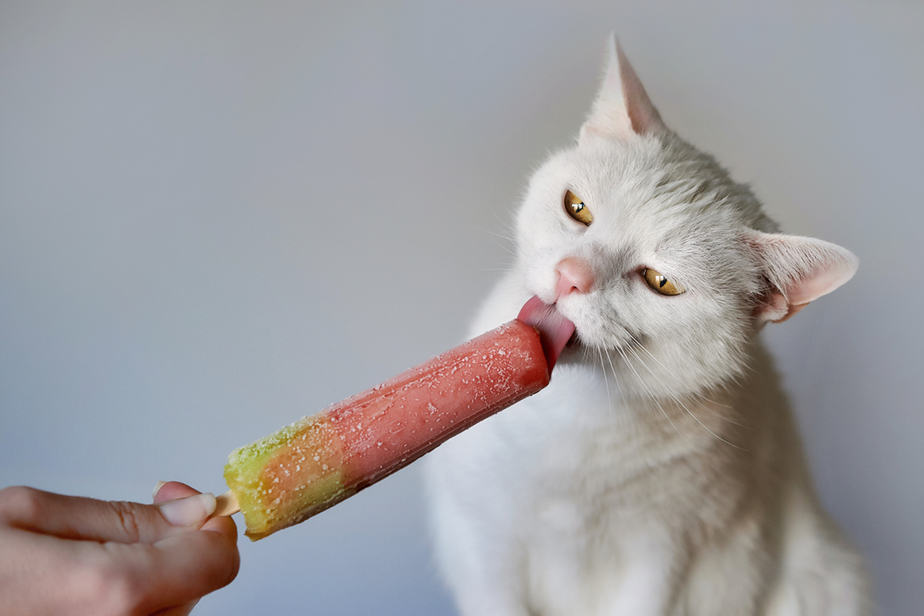
Other frozen treats
The process of freezing has made food storage super easy for us. Not only that, frozen food can serve as a refreshing treat on hot, summer days. Apart from popsicles and ice cream, let’s see if there are any more frozen treats cats can eat.
Gelato – is it safe for cats to eat?
Some people confuse ice cream with gelato, but there are a few differences. The main ingredient in ice cream is, of course, cream. This isn’t the case with gelato. To make gelato, one uses whole milk.
Similar yes, but not the same. Because of the use of whole milk, gelato is less calorie and fat-dense than ice cream. Gelato is therefore a better option for your furry companion, but still not the best one.
Sorbet
When it comes to sorbet, it brings slightly better news. What works in cats’ favor is that sorbet doesn’t contain dairy products. It’s made purely out of fruits and sugar.
Because of the lack of any cream, sorbet is richer in flavor, which can be intense for your feline. Even though it’s dairy-free, it still contains unnecessary sugar. While it’s healthier than popsicles, it doesn’t mean cats can eat it regularly.
Can cats get brain freeze from eating popsicles?
Brain freeze – also called ice cream headache. We all know the sensation when you eat or drink something cold. It’s happened to all of us and more often to children.
We say someone has brain freeze when they feel intense pain in the head or experience a temporary headache. It isn’t proven that cats get brain freeze, but you don’t want to find out!
It’s sometimes hard to tell what and how cats are feeling. However, common reactions of cats eating frozen treats such as popsicles and ice cream can show they experience some discomfort.
We can’t be sure if the frozen treats are the cause of the discomfort. Maybe your pet just has sensitive teeth! Whatever is the case, it’s better not to test it.
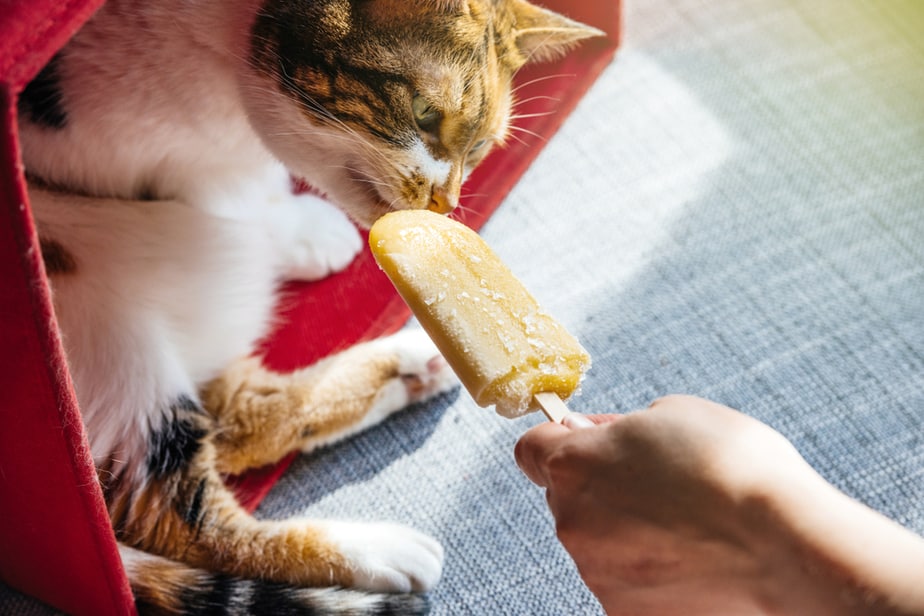
Cats and ice: What you need to know
I’m sure there’s not a cat owner out there who hasn’t wondered if cats can eat ice. Most of those thoughts come when we’re in the blazing sun. You watch your kitten searching for some shade and think about what could possibly cool her down.
The answer is ice cubes! It doesn’t cost as much as a fan but will do the job. It doesn’t take up much time – pour water into an ice tray, freeze it, and there you go.
Ice cubes are a great way to keep your fluff hydrated even on cool days. Some cats are lazy when it comes to drinking water and ice cubes can help. Their interesting and reflective shape might be something to intrigue your furball.
A couple of ice cubes a day will keep your cat hydrated and busy. However, you should monitor her when given ice cubes. If your cat gets excited, she may end up with a chipped tooth.
Catsicles – a safe alternative to human ice pops
Many cat owners have found themselves in a debate whether they should offer their pets frozen treats or ice cubes. This is no longer a problem. Now you can find various recipes for catsicles – homemade frozen treats for your fluffball!
Instead of dairy products, sugar, and other not-so-beneficial stuff for your feline, opt for some healthier ones. For instance, a bit of tuna or cat treats with some water or low-fat yogurt will do the trick.
If you have any of these ingredients, an ice cube tray, and a freezer, the party’s on! These healthy, lip-licking catsicles will keep your furry friend occupied and satisfied.
To conclude, cats eating popsicles can cause some health issues and it’s best to opt for homemade ones.
Read more: Can Cats Eat Donuts? Sweet Treats Or Health Hazards?
